by Tom Gaylord
Writing as B.B. Pelletier
This report covers:
- Condor
- Flexibility
- Goof jobs
- More power
- For the latest Spin Loc valve
- What it does
- The kit
- AirForce testing
- Widest range of power today/li>
- So what?
- Summary
Today we start looking at what I believe is a really big deal. This is what I teased you about on Tuesday. The Ring Loc Kit from AirForce takes the world’s most powerful and flexible air rifle and expands both its power and flexibility by an order of magnitude! That’s a strong statement that I will now begin to justify.
Condor
The kit we are looking at is for the AirForce Condor and also for the CondorSS. The Condor has a 24-inch barrel. The CondorSS barrel is 18 inches, so everything you read about the Condor will be just a bit less in the SS. As you know, in PCPs barrel length makes a difference.
I was working at AirForce when the Condor first came out and I hand-tested the first 100 production rifles to make certain they would shoot a .22 caliber Crosman Premier pellet at 1,250 f.p.s., because that was the AirForce ad campaign. They never launch anything without first making certain that it will deliver as advertised. We recorded each serial number and the velocity it produced with a Premier, just so we could be certain that each and every rifle we sold delivered what was promised. After testing those rifles we knew with confidence that the valve design was right on the money and production was making them the way we thought. We could go back to testing a sample of production and not every gun.
Flexibility
I have said it many times before — when you buy an AirForce sporting rifle you aren’t buying just one air rifle; you are buying an entire system. No other airgun on the market allows you to change barrels for three different lengths in 4 different calibers (that’s 12 combinations), has a primary power adjuster that operates without the use of tools, and has a secondary means of power refinement in the valve cap. The secondary means of power adjustment involves adjusting the height of the valve cap to control the length of the valve stroke. In turn, that determines how long the valve remains open for the air to flow. And it doesn’t stop there. You can put a standard air tank on a Condor to reduce the power, and even install a Spin-Loc Micro-Meter air tank to take it right down to nearly nothing (12 foot-pounds in .177 caliber). I tested that for you in 2008. So, a Condor can be almost whatever you want it to be.
Goof jobs
However — as soon as the rifle came out in 2004 the couch engineers had to “fix” the things that AirForce got wrong. One of the popular early modification was to install a heavier striker weight, thinking that a harder blow would hold the valve open even longer. What it did was pound the Delrin valve seat into the valve stem, ruining the valve. And, on Mr. Condor’s personal rifle, it also bent the aluminum frame of the gun, so that when we rebuilt his gun for him (one of the original 100 to go out) we weren’t able to repair the frame. We got his rifle working within specifications again and he stopped posting his fixes on the forums, but I often wondered where that poor beat-up Condor is today!
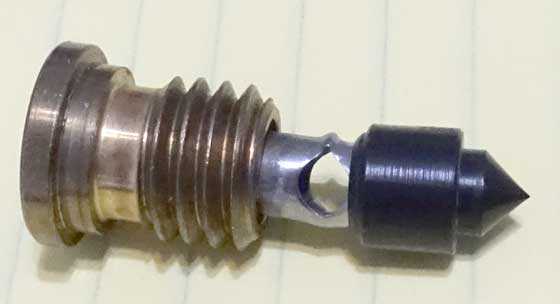
I saved Mr. Condor’s destroyed valve, or what was left of it (the valve cap and stem were broken off), to show people what happens when you fool with things you don’t understand. My Condor that’s just as old still works perfectly.
Now you understand my background. I was there and saw this from the inside. The Condor was a world-beating air rifle that produced up to 65 foot-pounds of muzzle energy when it first came out in .22 caliber. Today it is offered in .25 caliber and goes out the door capable of 80 foot-pounds, mostly due to the heavier pellets that have come into the market.
More power
As Tim the Tool Man Taylor tells us — what we need is more power! For those not living in the U.S., that’s a reference to a comedy television show, Home Improvement that ran from 1991 to 1999. It’s based on comedian Tim Allen’s humor. And AirForce has listened! The Ring Loc Kit that I’m reviewing for you starting today (and continuing for I don’t know how long) does just that. It takes the 80 foot-pound .25 caliber Condor up to 105 foot-pounds! That’s Escape territory, with the additional benefit of the large Spin-Loc Condor air tank instead of the smaller Spin Loc Escape air tank! So — there are more shots!
For the new Ring Loc valve
The Ring-Loc Kit is made to fit the new Spin-Loc tank that has the Ring Loc valve, only. If you have the older Spin-Loc tank that has two Allen screws in the valve cap, you need to buy a new tank with a Ring-Loc valve to use this kit. However, if you have an even older Condor like mine that has the quick-detach tank (the one that unscrews from the rifle and doesn’t have the gauge or quick-disconnect fill port) with one or two Allen screw(s) holding the valve cap to the stem, your gun has to be modified by AirForce to accept a Spin Loc tank. Then the Ring-Loc Kit will fit. Obviously if you buy a spare air tank for this kit, only buy the one that has the latest Ring-Loc valve.
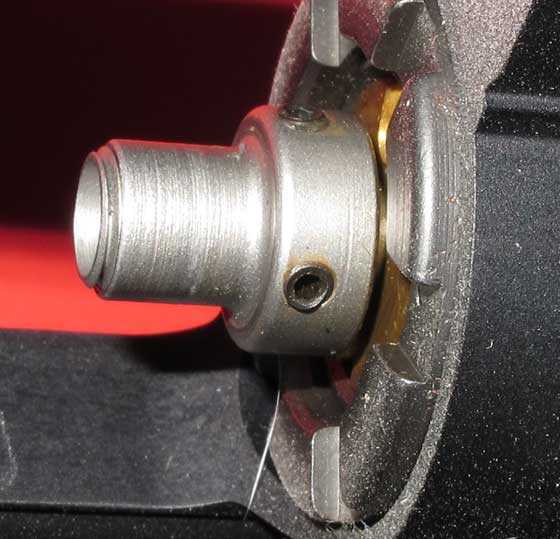
This is the Spin Loc tank you are familiar with. It has two Allen screws to lock down the valve cap at the proper clearance.
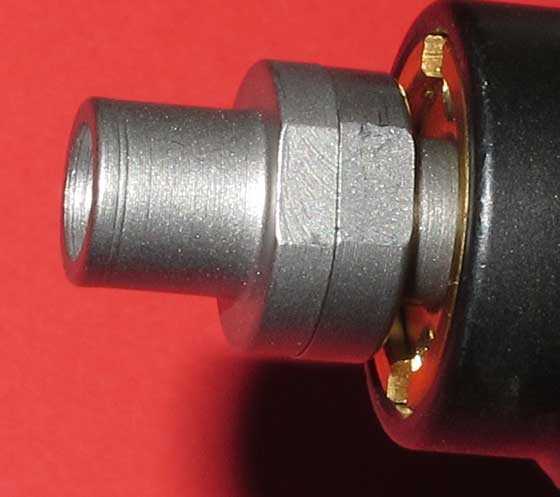
The new Spin Loc tank has the Ring-Loc valve cap.
What it does
Now I will get specific. The Ring-Loc Kit allows the owner to quickly adjust the size of what AirForce calls the orifice (we would call it the air transfer port) of the firing valve. A larger orifice allows more air to flow from the tank, resulting in more power. How much more power depends on the caliber and weight of the pellet.
Of course it also works the other way, as well. A smaller orifice give less power and more shots. Since the Condor is the most powerful smallbore air rifle you can buy, going down in power is also of interest. I already linked you to my report on the Micro-Meter tank, which takes the power as low as you can go, but what about the Spin-Loc Kit? How low can it go? Well, nobody knows — yet. Let’s look at the kit now.
The kit
The $50 Ring-Loc Kit comes with 4 orifices of fixed dimensions:
0.232-inches
0.166-inches
0.145-inches
0.123-inches
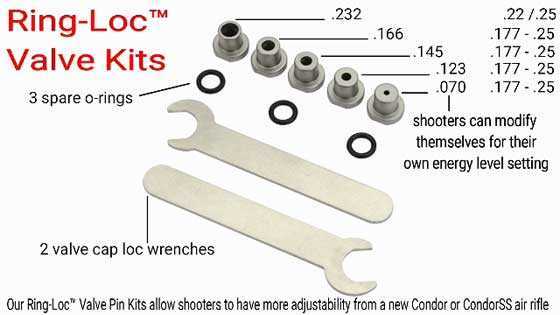
The Ring-Loc Kit comes with all of this.
There is one additional orifice with a hole that’s 0.070-inches in diameter that will not even shoot a .177 caliber pellet out of the Condor’s 24-inch barrel. That cap is for your own experimentation! Drill it out to whatever size you want and set up your Condor to do what you want.
You also get three replacement o-rings that fit between the valve cap and the ring lock underneath. I will have more to say about them in a future report.
Finally you get two wrenches that you use to adjust and lock down the ring lock valve cap.
AirForce testing
You get the most power from the largest orifice, which is the 0.232-inch one. However, that orifice does not work well with .177 caliber barrels. We aren’t very sure how well it works with .20 caliber, either, as tests have been run but more testing is needed.
Obviously as the orifice size decreases, the power does, too. And of course the shot count goes up. For the .177 Condor the 0.123-inch orifice is great, and for getting a lot of shots at consistent velocity the 0.145-inch orifice works quite well in .22 caliber. AirForce has a video on their website that covers the kind of results you will see with the different orifices.
What hasn’t been tested thoroughly is the Ring-Loc Kit at lower power. So, that’s what I’m going to do. I will first give you a synopsis of the data that’s been generated at the higher end of the power spectrum, then we will test the lower end together.
Widest range of power today
We know from my testing in 2008 that a Condor can deliver 12 foot-pounds in .177 caliber when it uses the Micro-Meter tank. AirForce has proven that they can dial a Condor with the Ring-Loc Kit down to around 22 foot-pounds in .177 caliber. That’s a 7-grain pellet traveling 1190 f.p.s. What I want to know about is the area in-between 12 foot-pounds and 22 foot pounds. In other words, can the Ring-Loc Kit make a Condor suitable to shoot indoors and still protect the bird feeder? I’m talking 14-18 foot-pounds or so. And, can the Ring Loc Kit make it unnecessary to buy the Micro-Meter air tank, altogether? Wouldn’t that be nice?
With all that testing yet to be done, though, we can still say conclusively that the AirForce Condor has the widest range of power available in a smallbore air rifle today — 12 to 105 foot pounds in 4 different calibers and 3 barrel lengths. They are so far out in front that second place is still over the horizon!
So what?
Here’s what! Want to get into PCPs and cover the spectrum for as little money as possible? Get a Condor. You can shoot indoors. You can protect the bird feeder and garden, you can hunt woodchucks at long ranges. You get a Lothar Walther barrel that offers great accuracy. One gun has it all, at least from a performance standpoint.
Summary
Don’t set up your Corvette with a 3-point Ferguson plow hitch just yet. You may still need your tractor for some jobs around the garden. But, glory be if the Ring-Loc Kit for a Condor and CondorSS isn’t something Tony Stark would be proud of!
I have so much more coming! Next time I will get to the results of some tests, plus I’ll show you how to install and adjust the orifices. New toys, guys!
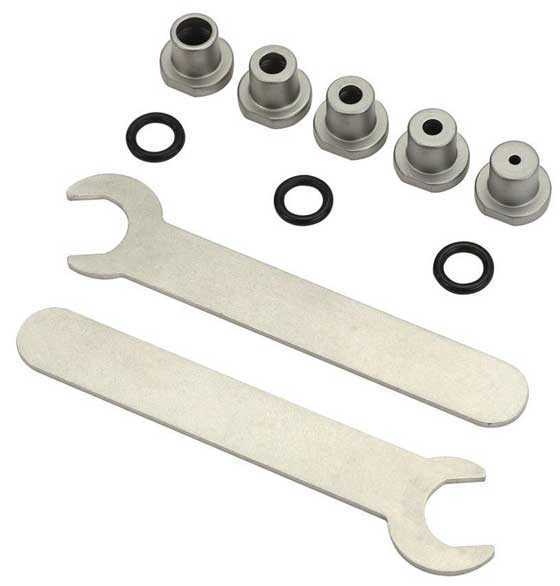

Sorry don’t get the Tony Stark reference?
Reminds me of the experiments that you did with the Whiscombe air rifle.
Orifice,
-Y
Tony stark is the person inside the Ironman suit in the marvel super hero movies that are popular in the United States.
Thanks,
-Y
I was looking for AirForce parts Monday, and saw this on their website.
I thought it was very cool.
My 12fllb UK legal Gunpower stealth (the tank date is 12/97, and rifle serial number 667) has after 22 years developed a slow leak, it Leaks from 3000 down to about 1500 and stops there.
Airforce has sent me the parts to fix it, and should be here tomorrow.
My newer talon with a high flow valve develops 25 ftlbs, but when I put the UK stealth tank on it, it gets 12.2ftlbs.
The UK stealth valve is fixed, the tophat and valve stem is machined as 1 piece, and the top hat orifice is .070, same as the DIY top hat shown above.
This is really great news for the people with condors, that want to tune to something other than what the gun came with.
The down side?
Special tank/valve, and only fits the newest guns unless you retrofit your old one.
I saw the kit sometime back. Almost got it but my Condor SS in .25 caliber just shoots to good to be messing with. I decided to leave well enough alone.
But it will be interesting to see your lower velocity tests.
Well as far as flexibility it may be true now even, but FX is at least challenging that ignoring .20 and including .30 and in the process of producing slug barrels for use of cast rounds in .25 & .30 as the base barrels are for traditional skirted pellets. Not trying to denigrate AirForce offerings plus i think we are talking two levels of expenditure, but i have no skin in the PCP game springers & rimfire here giving my 2 cents where you all have more experience. I am limited in scope though or needs but thought long and hard about the Texan .257 or an FX impact x 700mm in the end opted for another traditional firearm.
It is just so much cash getting into the PCP ecosystem as i have no want to hand pump other than an Aspen and how long until that starts leaking. More power to the rest of you in the PCP end of it and when i do jump in it will be all the way or not at all. Always good to be well informed about every product i can so when i do i don’t go wasting time on the wrong stuff.
Very interesting. It will be nice to learn more about the Air Force’s inner workings/system. I have not delved too far into them.
Good Day to all,…….. Chris
I am glad to see AirForce finally offer an orifice kit. There has been an aftermarket kit out for quite a few years now that works on the “old” valves that use the set screws. It uses replaceable orifices in the valve cap.
These air rifles are indeed a tinker’s dream come true. If you are only going to have one PCP, it should be an AirForce. Once you come to understand how it works, you are limited only by your imagination and the thickness of your wallet.
This is going to be a very interesting series of tests.
B.B.
I’m looking forward to reading more of your testing – especially that you will be looking at the low to mid range power settings. Like that the power can be adjusted to what is needed instead of the maximum that is possible. Always curious about the inner workings of airguns!
I have a new assistant in protecting the bird feeder. For years we had a family of foxes to help with the cleanup but they haven’t been here for two years now. Recently, a raven (we named him “Gomez” after the character in the Adams Family) has taken cleanup duty over from the foxes. Gomez has developed a taste for grackles and has learned very quickly that one shot means “dinner is served” and multiple shots means that I am out on the range. Ravens are interesting birds, it’s nice to be able to watch him at relatively close range (25 30 feet) as he will often come over to watch me working in the yard.
Cheers,
Hank
Hank
I have a big red tail hawk that is like that. Maybe not 25-30 feet. But definitely 15-25 yards.
Here’s a picture last month when we got our last snow. This is about 25 yards.
And this was the other day at about 15 yards. This is to the right of where I shoot from the breezeway.
And what’s cool is it’s like it’s showing off when it gets a bird. It will dive down different ways to get the bird off the ground.
The one I like is it flys over head then folds it’s wings in and dives in a spiral type corkscrew gets the bird and he flys up on it’s favorite telephone pole and eats. Pretty cool to watch.
Beautiful bird GF1!!
We have a variety of raptors (from kestrels upto [very occasionally] a bald head eagle and a variety of owls as well) that show up here and the red-tail is one of them. Always nice to watch!
Officially spring here – Ice is off the beaver pond, dozens of turtles sunning on the logs and the frogs are raising a ruckus in the evenings. So glad that winter is done and it’s shooting time!!
Hank
The pictures don’t show the true size. It’s seriously as big around as a telephone pole.
Anybody wanting to see some nice pictures search “red tail hawk” then click on images. Some really neat pictures.
But yep it’s definitely spring time. The turtles are out in the pond and the frogs are chirping.
Pretty soon the momma deer will be bring the new fawn out. Always enjoy seeing that. And the carpenter bees are hot and heavy this year too.
Heck I already cut my grass twice. Going on number 3 tommorow. Always like a fresh cut lawn for my weekend shooting. 🙂
GF1,
Very cool…we have some red tails in our area also but I don’t see them come down any where near. When I see them they are very high circling over the field behind our home. I get my binoculars out to watch them sometimes. We also have some of the smaller Cooper hawks. They does come down and sit in the big maple tree out front and watch the bird feeders and the shrubs, where he knows the birds hide. I can tell when they are in the area because all of the birds at the feeders suddenly take off at the same time, except of course for the mourning doves, which aren’t aware of what’s happening.
Geo
The blue Jays give the red hawk trouble all the time. They ain’t afraid. We’ll untill the red hawk catches them off guard.
It eats up on top the telephone pole and the blue jays fly around sqwuaking at it. Sometimes they even land right next to it. It acts like they ain’t even there. All of a sudden the Hawke will go after one of the jays. They scatter then.
But them blue Jays are a nuisance. They get the baby swallows and even baby squirrel. Problem is they are on the protected species list. How stupid is that is all I can say. They wasn’t when I was a kid. From what I see now days and how many there are they need to be taken off that list. Anyway what do I know.
GF
We still got Rocky (2 nights ago, 930 PM).
TT,
I have caught a red tail squirrel, 4 times, up on it’s hind legs, with it’s head under my car. I open the door and make some noise and off it goes. War is on! 😉
I still remember just getting set up with the .25 M-rod and still taking stuff out. I sat down to do some scope adjustment and rest refinement, being rather quiet…. then go back in and get the rest of the stuff. Suddenly,….. a 20# plus ground hog came out from under my raised shed,.. 15′ in front of me and just sat there! He did not even know I was there for 2 or 3 minutes.
Did I “pop” him? Not quite. My ammo/mags was still some of the items, (yet) to be brought out.
🙁 Chris
I need to just strap a Condor on my back when in the yard,…….. kind of like the Samurai do with the swords. (back strapped scabbard?) Always ready to draw at a moment’s notice. 😉
Chris
You know you have two problem rodents hanging around now . Be ready for them, and you will get them eventually.
tt
tt,
A home made side to side slider window (to insert into an otherwise open window, sans normal screen) has been on the to-do list for awhile. Of course, when I am out shooting,… squirrels are nowhere to be seen. Basically,… a slider window that can keep the A/C and/or heat inside, yet be ready to stealthily slide open and take a shot.
I am not sure what it was called back in the Medieval days,… but I am pretty sure that castles had “turrets” from whence to shoot. Ok,… not for so much on keeping the heat and A/C in, in those days,….. but you get the general idea. 😉
Chris
Chris USA,
An arrowslit (often also referred to as an arrow loop, loophole or loop hole, and sometimes a balistarium) is a narrow vertical aperture in a fortification through which an archer can launch arrows. They were also cut at oblique angles on the inside face to give the Archer/Gunner a wide angle of fire. You could also use a Latex poke-through valve surrounded by glass or Plexiglass like they use in laboratory materials handling chambers. Replace the glass or Plexiglass with balstic Perspex in case they start returning fire!
shootski
Watch out for those squirrels. They will chew the insulation off from the wires and cause a lot of damage. Raccoons also will do this.
Funny you mentioned the big woodchuck under your building. I have a 10×16 barn too that sets on 4×4 stringers. Just this afternoon I saw a woodchuck scurry under my barn. I had one last year get under my barn and he would only come out about 3′ from my barn so I couldn’t shoot him. Finally, I got my old BB gun out and shot at him under the barn. After hitting him several times he finally ran out and over under the neighbor’s deck. Now I have another one to deal with. If he get’s out away from my barn a few yards the Urban will take care of him. They can be very destructive too.
Chris USA,
Not only will they chew wiring harness insulation but my daughter-in-law had them (ground squirrels) eat the plastic taillight assembly on the Subaru Legacy now apparently being made of the new generation of recyclable plastic! It was spendy to replace too!
But I guess it was “recycled!”
shootski
Shootski
Yep them squirrels will chew through alot of things. Once they get it in their mind they need to be there.
I seen them chew rafters on a barn and collapse a corner of the roof when I was a kid out on the farm. Sparrows are just as bad.
TT
Cool. Them flying squirrel are neat little critters.
Blue Jays! They are a nuisance aren’t they? I have several species of woodpecker that come to my woodpecker feeder. I have the little Downys, Hairys, Redbellies, and Northern Flickers. My favorite is the Redbelly because he is the only bird I’ve seen that will drive a Blue Jay away from the feeder. When the Redbelly comes to eat the other birds leave and watch him eat from a distance. Love my woodpeckers, except when the Flicker pecks on my eaves trough early in the morning and wakes me up. This is what the Flickers do to call a mate.
Geo791,
Consider yourself lucky!
Our Woodpecker(s) has found our chimney metal rain cover/spark-arrester
makes a near perfect mating drum! First light finds him making one heck of a DIN!
shootski
Geo
Yep with the blue jays.
And we have woodpeckers too and song birds. If a blue jay is anywhere close to the bird feeder the other birds won’t come near. I chase them away since I can’t shoot them with a couple loud claps of my hands. But usually it don’t take that. They get a glimpse of me and their gone.
And the dang jays are noisy too. Something needs to be done about them.
B.B.,
Is this concept going to be moved into the other lines of AirForce PCPs? Say, the Texan line? It might be useful for accuracy tuning for specific rounds.
shootski
shootski,
I don’t know and AirForce never mentioned it to me. They will probably wait to see how well the public accepts this kit.
With big bores nearly all owners want the greatest power. Plinking at low power isn’t very popular with them.
B.B.
B.B.,
I wasn’t thinking plinking but I understand the typical new Big Bore owners mindset!
I guess I would need to have some experience with AirForce Texans to know if the kit would have any utility with tunes for different rounds and purposes. I have followed AirForce’s progress over the years and if it were not for Quackenbush I would probably have been an early adopter…maybe the day is coming when my gunroom sees an AirForce or three!
shootski